There’s a familiar scent that only leather can offer – a hint of the rugged, timeless, rock-n-roll spirit. As a dedicated luthier, this smell has been my constant companion since 1994. Crafting leather guitar straps is not just about function. It’s about creating a tangible bond between the musician and their instrument, a bespoke piece of art that echoes their individual rhythm and style.
The day I successfully completed my first leather guitar strap DIY project marks a profound shift in my career. I vividly remember the exquisite design I etched into the raw hide, and the satisfaction that every stitch was exactly as intended. But the real triumph? That lies in the journey, one that you can also embark on.
In this comprehensive leatherworking guide, I will share the insights I’ve gathered over decades of weaving passion and craftsmanship with each guitar strap pattern. Let my experience inspire you, guide you, and fan the flames of your creativity. Strap in – we’re about to embark on a fascinating voyage in the DIY world of leather guitar straps!
Understanding the Basics of Guitar Straps
Parts of a Guitar Strap

In my extensive career as a luthier, I’ve found understanding the basic components of a guitar strap essential in making a guitar strap that’s functional and aesthetically pleasing. The strap is composed of three main parts: the end pieces, the length adjuster, and the main strap body. The end pieces are what attach the strap to the guitar; they need to be sturdy and secure. The length adjuster allows for the changing of the strap’s length for the player’s comfort. Lastly, the main strap body which holds the majority of the weight, should have sufficient width to distribute pressure evenly across the shoulder.
This thorough understanding outfits me with the necessary acumen for making a guitar strap that’s not only eye-catching but also ensures optimal performance. Currently, I’m delving into the different types of guitar straps, each offering unique material and design potentials. My goal is to equip you with the knowledge to not only understand the functional aspects but also to empower your creative instincts while designing your leather guitar strap.
Types of Guitar Straps
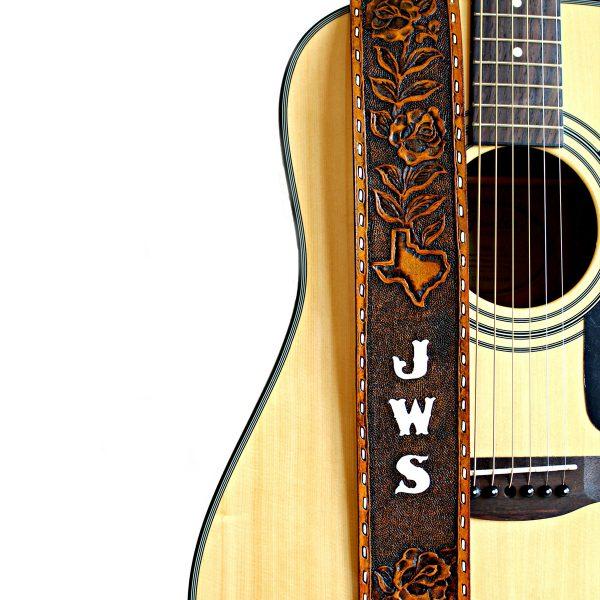
Continuing from the basics, we delve into the myriad types of guitar straps. Crafting a variety of handmade guitar straps over the years has broadened my understanding of their unique forms, which, surprisingly, cater to distinct guitar genres. This appreciation of diversity contributes significantly to the creative process of designing a unique, DIY leather guitar strap.
From the traditional and widely used 2-inch wide strap to svelte ‘skinny’ straps favored in punk culture, each type bespeaks one’s personal style. For those who prefer a rustic charm, a ‘western-style’ strap with embellishments might resonate. Additionally, there are ‘comfort straps’ excessively padded to ease the burden of heavy guitars, essential for long practice sessions or performances.
Understanding these types isn’t simply about diverse genres or aesthetics; it’s about maximizing performance. The type of strap you choose can enhance playability—the right strap keeps your guitar stable and accessible, allowing you to focus on your playing.
Once we’ve grasped these specifics, we advance to the importance of the material in the strap. Being a crucial element, the right material will add to your comfort, durability, and aesthetic appeal of your handmade guitar strap.
Material Selection and Preparation
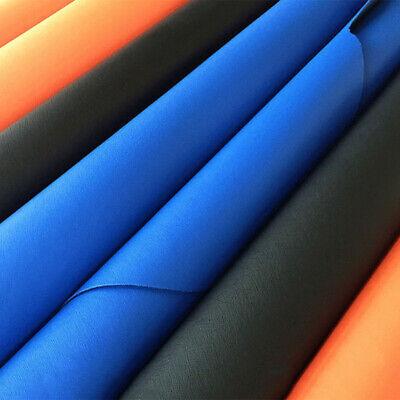
My journey into the world of instrument design and ergonomics has ingrained in me the importance of meticulous material selection and preparation. Through years of fine-tuning my craft, I have learned that the right kind of leather and appropriately prepared tools can make or break a custom guitar strap project. This leather strap tutorial is a culmination of all those experiences, and I hope my insights can prove useful to you.
The first rule of thumb in instrument strap crafting is selecting high-quality hide. Top-grain or full-grain leather is a top choice. These types provide durability and strength that can withstand years of use—a much-needed factor considering guitarist’s dynamic performances. Top-grain, being sanded and polished, balances both aesthetics and functionality, while full-grain, with its natural imperfections, gives a rustic charm that appeals to many.
Moving on to tools – I have always vouched for a basic but reliable set of leatherworking tools. A good and sturdy rotary cutter or leather shears for precise cutting, a solid aluminum or rawhide mallet for setting your rivets and punches, and a top-quality hole punch and rivet setter. Of course, this doesn’t cover everything you’ll need for your strap. Still, these are the essentials that no leatherworker—novice or veteran—should be without.
Ask yourself, what kind of leather and tools should you use when building a guitar strap, and why does it matter? Your selection can be the difference between a strap that lasts a show and a strap that lasts a lifetime. Would you rather have a guitar strap that frays and tears under the strain of a performance, or a reliable companion that radiates your musical spirit? It’s the careful thought given to the materials and tools that defines the aesthetic and longevity of your final product.
Once you have your materials and tools, proper preparation is essential. Leather should be conditioned before you start. Conditioning prevents it from drying out and cracking – a common issue with leather goods. Properly conditioned leather is easier to work with and ultimately results in a better end product. Preparing your tools is just as important. Ensure they are clean and sharp. With all this ready, you’re all set to start creating your custom guitar strap.
From my experience, it’s the passion for craftsmanship and the respect for the material that elevates a handmade strap above a mass-produced one. Whether you’re a professional musician looking to add a personal touch to your gear or a DIY enthusiast seeking a new venture, dedicating attention to selecting and preparing your materials will make your instrument strap crafting process worthwhile. My years spent researching and experimenting have honed this knowledge, and I am more than pleased to guide you through this too.
In the subsequent sections, we’ll dive deeper into designing your guitar strap, crafting the same, personalizing it, and adding finishing touches to make it a piece that’s truly your own. Stay tuned as we journey through this comprehensive, hands-on guide to crafting your leather guitar strap.
Designing Your Guitar Strap
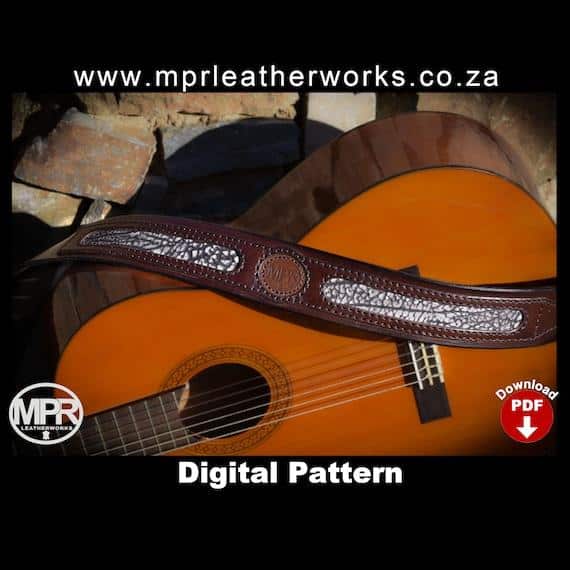
Throughout my career as a leatherworker, the art of creating custom guitar straps has occupied a special place in my toolkit. The guitar strap – whether it’s crafted for a beginner musician or a seasoned professional – is far more than a mere accessory. It’s an extension of the guitarist’s personality and an essential tool that, if designed well, enhances performance, provides comfort, and radiates a unique style.
So why is an artistic vision just as important as the ergonomic considerations when designing a guitar strap? The answer lies in the profound connection between aesthetics and function. A guitar strap can be flawlessly ergonomic, but without a distinctive artistic vision, it lacks the ability to truly express the musician’s style and personality. Our guitar strap template incorporates both these elements, marrying form and function superbly.
When I begin a new project, I start by considering the guitarist’s needs and preferences. What type of gigs will the strap be used in? What is the guitarist’s personal style? How many hours will the guitarist wear the strap in a single session? This understanding of utility forms the backbone of the custom guitar strap design.
I then infuse the specific design elements that bring the strap to life, moving into the realm of aesthetics. Here’s where we can play with custom embroidery, leather tooling patterns, color shades, and finishes. It’s an exciting stage, letting creativity run wild within the parameters set by comfort and usefulness.
What truly sets apart the craft of making leather guitar straps is the limitless design opportunities leather offers. With years of experience under my belt, I can confidently state that the array of leather tooling patterns is astounding, enabling the creation of truly one-of-a-kind pieces. Whether it’s intricate floral designs, guitarists’ initials or band logos, we can carve illusions limited only by our imagination.
I’ve found that the journey of designing a guitar strap becomes a process of self-expression, as I strive to metamorphose an ordinary strip of leather into a work of art that resonates with the musician. But at the same time, I never lose sight of the ergonomic considerations. Comfort and durability are as integral to the creation as the artistic flair I infuse into each piece.
As we move forward in this comprehensive guide, I’ll delve into the practical aspects of crafting a guitar strap, sharing the nuances and tricks that I’ve gleaned from years of experience in this industry. But as you step forward into this journey of creating a stunning leather guitar strap, remember, ergonomics and aesthetics must go hand in hand. One without the other results in a strap that’s either uncomfortable or unremarkable – and we strive for nothing less than extraordinary.
Crafting the Leather Guitar Strap
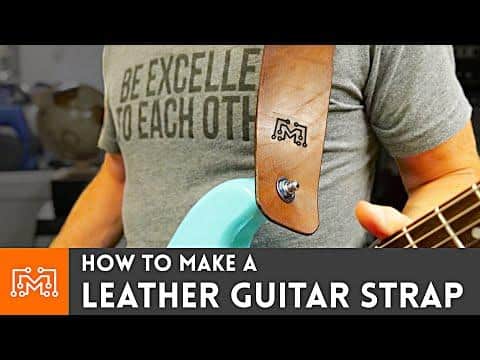
Building on from our material selection and preparation, let’s dive right into the heart of the project – crafting the leather guitar strap. With the right technique and a dedication to detail, we are going to transform a simple leather strip into a work of functional art. And remember, patience is key in the world of leatherworking, with each stage requiring diligent attention and time.
Position yourself well in your workspace, spread out your materials in front of you, and ponder this question – ready to become a master leatherworker and craft the perfect guitar strap? Because that’s precisely what’s next on our list.
Developing the intricate process of stitching leather was a result of walking down the path of repeated trials and errors. The art of emphasis is not just about technical proficiency, but also relies heavily on each unique leatherworking pattern you chose to use. This journey is about immersing yourself in the process of creation and producing a product that truly sings to your own tune.
The first stage of crafting the strap is the most crucial – cutting the leather. To do this accurately, you thoroughly measure out the desired length and width of your guitar strap. I always recommend taking extra time during this stage as errors are hard to correct down the line. Marks should be made with a pencil for the best visibility. Only after double-checking your measurements, cut along the marked lines using a sharp utility knife.
Next comes preparation for stitching, and if you ask me, that’s the most exciting part. This is when guitar strap leatherworking truly starts to come to life. Lay out your leather strap flat and mark where you want your stitches to go. Ensure that these marks are consistent and evenly spaced for perfect results. Stitching isn’t just a functional part of crafting musical accessories, it’s also a defining aesthetic feature, so take time to create a pattern that suits your specific style.
Then, we transition into the actual stitching process. Utilizing the saddle stitch is my go-to method for its elegant finish and durability. Take your awl, position it at your first mark, and carefully push it through the leather. Repeat for each mark, ensuring that each hole is clean and consistent. Thread your needle and start stitching through each hole, following the pattern you have previously marked out. The repetitive process is almost meditative, a soothing rhythm of craftsmanship.
Keep in mind; no matter how skilled you are, practice makes perfect. So, if you don’t get it right the first time, don’t worry. The beauty of this process is that there’s always room for growth. And remember – the most important thing here isn’t just creating the strap – it’s the journey you take in crafting it.
Once that’s done, your strap is almost ready. All that’s left is to add your personal touches and finish it off. But, that’s a story for our next chapter.
Delving into the intricate world of leatherwork has provided me with a kind of satisfaction that few things can. And the most rewarding part? The ability to pass on this knowledge and inspire others to create the perfect accompaniment for their beloved stringed instruments, steeped in personal expression and individuality.
So grab your tools and materials, and let’s continue crafting.
Personalizing and Finishing Touches
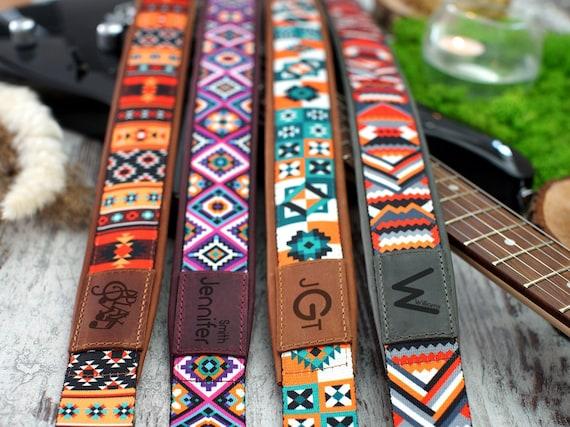
I’ve shared with you the ins and outs of constructing a leather guitar strap, including the function and importance of every little detail we’ve included so far, from material selection to crafting the actual strap. Yet, even as we near the end of this leather craft guide, we’ve only just begun to explore the myriad of possibilities. Let’s take it a step further, diving headlong into one of the most rewarding stages: personalizing and adding the finishing touches to your strap.
After all, how can you bring a touch of your personality into your guitar strap, making it truly unique? That was a question I grappled with myself during my early days in leatherworking. Throughout my academic career in engineering and subsequent editorial experiences, the opportunity to interweave facets of creativity within technical precision has always been particularly exhilarating. In leatherwork, I found the perfect avenue to express those seemingly disparate aspects—precision, creativity, and personalization—in a tangible form. Now, let’s explore how we can infuse your personalized guitar strap with a similar touch of individuality.
Whether it’s an intricate design, a potent symbol, or your signature emblazoned across the strap, personalizations are a reflection of you—a sentiment that can resonate in every performance. And with the free guitar strap pattern we’ve followed, you have a blank canvas to unleash your creativity on. Perhaps you have a favorite quote or song lyric you want to inscribe, or maybe you have a knack for abstract designs, intricate patterns, or even just a bold color that feels distinctly you. The potential is limitless. From dyeing, painting, stitching to stamping, the various techniques we can employ will not only make your strap unique but also offer an engaging tactile experience.
And let’s not forget, adding finishing touches involves more than just aesthetics. It’s also about making your guitar strap last. Protecting the leather’s surface by applying a finish, such as a coat of wax or oil, can enhance the strap’s durability while adding a pleasing sheen. It’s these final touches that will tie together all the work you’ve put in and make your strap truly your own.
When all is said and done, crafting a leather guitar strap might seem like a daunting process. But remember, it’s the journey that matters as much as the final product. As we segue into the final segment of our guide, take a moment to look back on the ground we’ve covered, and anticipate the final result—a personalized leather guitar strap that is a unique blend of your craftsmanship, creativity, personality, and passion.
FAQs
What materials are needed for a DIY leather guitar strap pattern?
How to ensure the correct size for your guitar strap?
How to customize the design of a DIY leather guitar strap?
Conclusion
In summarizing this immersive journey through leatherworking, I hope to have imbued my passion and shared knowledge, making the path clearer for those crafting their custom leather guitar strap. It has been my pleasure guiding you through understanding the basics of guitar straps, their various parts and types, selection and preparation of materials, design elements, actual crafting, and finally, adding your personal touch to the finished product.
I must emphasize, making a guitar strap is an art, demanding patience, precision, and a deep commitment. Each step holds significance, from choosing the right leather and crafting tools, to imparting your unique design onto it. The end product is not just any guitar strap, but a piece echoing your creativity.
You now shoulder an understanding soaked in expertise and personal touch. I truly believe that armed with this knowledge, you have the power to craft a masterpiece. Remember, each creation is a testament to your evolving craftsmanship and a homage to the everlasting charm of leatherworking. So, start crafting, let your guitar sport a strap that is as unique as the music you create!